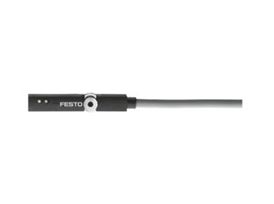Overview of FESTO (Festo) Proximity Switch SIEN-M12B-NS-K-L
FESTO (Festo), as a renowned company in the field of automation technology, plays a significant role in industrial automation systems with its proximity switch SIEN-M12B-NS-K-L. This proximity switch is a non-contact position sensor, mainly used for detecting the approach or presence of objects, capable of quickly and accurately issuing detection signals without direct contact with the object being measured.
From the perspective of design, SIEN-M12B-NS-K-L adopts a compact M12 size housing, which allows for easy installation in various confined spaces, making it suitable for industrial scenarios with strict installation space requirements. The housing material is robust and durable, offering good protection, capable of withstanding harsh industrial environments such as moisture, dust, and vibration, ensuring the long-term stable operation of the equipment.
Electrical performance-wise, the proximity switch has high sensitivity and reliability. It can detect various metal and non-ferrous metal objects, with a moderate detection distance, meeting the needs of most industrial applications. Moreover, its output signal is stable, with strong anti-interference capabilities, effectively avoiding the impact of external interference on detection results, ensuring the accuracy and stability of the system.
Working Principle and Features of FESTO (Festo) Proximity Switch SIEN-M12B-NS-K-L
SIEN-M12B-NS-K-L proximity switch employs advanced induction technology. Its working principle is based on electromagnetic induction. When the object being measured approaches the sensing surface of the proximity switch, it causes changes in the magnetic field around the sensing surface. The internal circuit of the proximity switch detects these changes and converts them into electrical signals for output. This non-contact detection method has many advantages, such as not causing wear to the object being measured, fast detection speed, and short response time.
The proximity switch has various features. First, it has good repeatability; the consistency of the output signal when detecting the same position of an object is very high, which is crucial for industrial production processes requiring high-precision detection. Second, it has a wide operating temperature range, capable of functioning normally in an ambient temperature range of -25°C to 70°C, adapting to industrial production needs in different regions and seasons. Additionally, it has short-circuit protection and reverse polarity protection functions, effectively preventing damage to the equipment due to circuit faults, enhancing the safety and reliability of the equipment.
In terms of connection, SIEN-M12B-NS-K-L uses a standard cable connection method, making installation and replacement convenient for users. The length of the cable can be chosen based on actual needs, providing users with greater flexibility. It also supports various output modes, such as NPN normally open, NPN normally closed, PNP normally open, PNP normally closed, etc., allowing users to choose according to the specific requirements of the control system.
FESTO (Festo) Proximity Switch SIEN-M1
Proximity Switch SIEN-M12B-NS-K-L belongs to the Sensors series under FESTO company, model number SIEN-M12B-NS-K-L. To purchase or inquire about Proximity Switch SIEN-M12B-NS-K-L, you can directly contact 158 0047 0089 (Mr. He).



